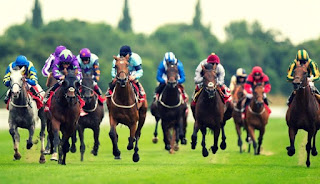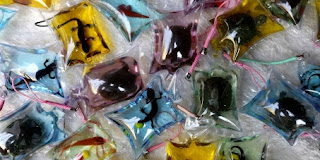The Cruelty behind the Horse Racing Industry
You bet, they die.
Horse racing has a reputation for being an elegant sport, attracting many wealthy members of the public as they fill the audience - women with their fancy hats and designer dresses, and men with branded suits.
However, behind the romanticized facade of horse racing lies a world full of deaths, injuries, and drug abuse. As the spectators show off their fancy outfits, the horses, who are viewed as nothing more a commodity, are running for their lives.
Starting the race
Racehorses are usually started when they are just 2 years old, which is far too young an age. Their bones are still growing and their bodies are not yet accustomed and ready to handle the pressure of running full speed on a hard track. Due to this, they often suffer more injuries compared to older horses.
These racehorses have been genetically modified through selective breeding to be able to run 30 miles per hour on skinny legs and tiny ankles while carrying over 1000 pounds of their body weight. The skinner their legs are, the lighter the horses, and the faster they can run. However, this is a recipe for disaster and broken bones are often the result.
Behind the scenes
Horses who are forced to race are often threatened with harsh beatings with the use of whips and sometimes even illegal electric-shocking devices to sprint at speeds so fast. This leads to the horses frequently sustaining injuries and even hemorrhage from the lungs.
Due to the frequent and obvious injuries, it is no surprise when jockeys and trainers inject the horses with both legal and illegal drugs to cover traces of their injuries, making the horses numb so they are unable to feel the pain and can continue racing.
Horses who bleed from their lungs and windpipe, a condition known as exercise-induced pulmonary hemorrhage, will be given a drug called Lasix or Salix to decrease the bleeding, instead of proper veterinary care.
These drugs will also enhance the horses’ performance and speed up their metabolism by forcing them to lose weight so they can run faster.
Many horses are also given liquid nitrogen to increase blood flow in sore muscles to soothe the aching muscles. However, this process, known as “freeze firing”, more often than not leaves the horse with deep surface wounds.
Mental and physical Suffering
Horses in the racing industry are also subjected to mental suffering. Horses are naturally herd animals. They live in large groups and graze together. However, in the racing industry, these horses are individually confined to stalls for up to 23 hours a day.
Without any social and environmental stimulation, these race horses can develop stereotypic behaviour, called stereotypes, such as crib-biting and even self-mutilation. These behaviours are a strong indicator that the horses are not receiving the proper care they need.
Many racehorses are also found to have suffered from bleeding stomach ulcers due to them being fed high concentration diets such as grains during their training period instead of letting them graze.
End of the race, end of their life
Every week, an average of 24 horses die on the U.S race tracks due to them sustaining skeletal injuries that are so extreme they cannot be healed such as fractured bones and torn ligaments. And this number does not even take into account the numerous other horses discarded by the racing industries when they can no longer make any profits for the industry.
During the race, if a horse suffers a traumatic fall, a screen is rushed to the track to shield the disappointed audiences from the brutal reality of the racing industries.
If the horse breaks a leg or shoulder, the bones will break into many little pieces, making it almost impossible for the vet to repair. Even if the injury can be treated, it is highly unlikely that the horse will ever compete again.
Even if the mare or stallion can be used as a stud for breeding, it is very expensive to restore a racehorse to what it was before and the industry is unwilling to spend that amount of money when there are cheaper ways to get new horses.
It does not get any better when these horses retire either. You may think retired racehorses graze on beautiful green paddocks, but that is just a mere fantasy. The vast majority of failed or older racehorses who can no longer run fast enough will be shipped to countries such as Canada and Mexico for slaughter.
Horses as young as 5 or 6 years old who do not bring in profit will also be discarded as nothing more than a commodity and sold for human or pet consumption directly through auctions.
The long-distance transport of the horses to slaughterhouses are not well monitored or regulated. The journey can take up to several days which can be very stressful for the horses. They are crammed into confined places designed for cattle and are starved until they reach the slaughterhouse.
Because horses are not designed for stability, they often lose their balance during the transport, resulting in injuries and bruises and are forced to endure the pain until their lives are ended.
This is the life of racehorses. They are viewed as money making machines. And once these “machines” stop working, they will be discarded and replaced.



Sad......
ReplyDeleteThis is just terrible! Unfortunately it seems that money is the root to most of the evil in the animal cruelty problems...SAD
ReplyDeleteSo many people who claim to be horse lovers, yet race and hunt with their horses. How they can do that to a creature they say they love is beyond comprehension.
ReplyDeleteSuch a sad and often brutal sport. Ive seen a horse break it's leg at a race. Not pleasant....
ReplyDelete
ReplyDeleteIt's a very cruel thing, you're right, and for this you do well to talk about it because still too few people know the truth behind this sport!
I understand your opinion and there are many in the industry that abuse the horse/don't care take of the horse properly. It is sad. Many are in it just for the money.
ReplyDeleteSad to know this, I never thought about this is happening with horses. Thanks a lot for sharing this useful information.
ReplyDeleteI never all of that. I actually thought the horses live normal lives. I used to ride horses as a sport but never really got into that
ReplyDeleteThis is very sad. Sounds like its money driven :(
ReplyDeleteThank you for shining a light behind this nation wide accepted sport. It is sad that money drives man to miss treat such a caring and loving animal.
ReplyDeleteThis is unthinkable. Horrible. Grisly and Disgusting. I hope more people learn the truth about this "sport" and things change for those beautiful animals.
ReplyDeleteI knew Greyhound racing was brutal and cruel, but never suspected horse racing was just as bad. I had a feeling not everything was on the up and up, but this is so disgusting. These beautiful animals don't deserve to be treated so horribly.
ReplyDeleteThis is very sad. It is not fair to treat them so bad. Thank you for sharing this information .
ReplyDeleteHeartbreaking to know these stuff. So brutal for the animals, I hope it will change soon.
ReplyDeleteThis is horrible. How can we not know this is going on?
ReplyDelete